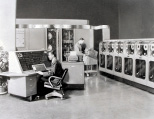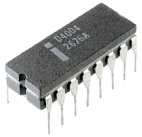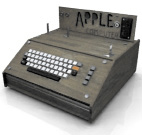
Научная электронная библиотека
Монографии, изданные в издательстве Российской Академии Естествознания
Unit 2. THE HISTORY OF COMPUTERS
READING ACTIVITIES
1. Read the text and find the answers to these questions.
1. What was the main principle of Babbage Analytical engine? When was it produced?
2. Why was Herman Hollerith’s invention so popular?
3. What spheres did first analog and digital calculators with electromechanical components appear in?
4. Who is known to be the inventor of the first electronic computer?
5. What was the first all-electronic digital computer used for?
6. Where was the ENIAC developed? What for?
7. What was the first successful commercial computer? Who bought it?
EARLY HISTORY OF COMPUTER INDUSTRY
In 1821 Charles Babbage, professor of mathematics at Cambridge University in England, created the Analytical engine, a mechanical calculator that could automatically produce mathematical tables. Babbage conceived of a large-scale, steam-driven model that could perform a wide range of computational tasks. The model has never been completed as revolving shafts and gears could not be manufactured with the crude industrial technology of the day.
By the 1880s manufacturing technology had improved and practical mechanical calculators, including versions of Babbage’s Analytical engine, could be produced. The new technology achieved worldwide fame in tabulating the US Census of 1890. The Census Bureau turned to a new tabulating machine invented by Herman Hollerith. Hollerith’s invention eventually became the foundation on which the IBM Corporation was built.
Analog and digital calculators with electromechanical components appeared in a variety of military applications in 1930s. Many people credit the invention of the first electronic computer to John Vincent Atanasoff. He produced models of computer memory and data processing units at the University of Iowa in 1939 although had never assembled a complete working computer.
World War II prompted the development of the first all-electronic digital computer, Colossus, which the British secret service designed to crack Nazi codes. Similarly, the need to calculate detailed mathematical tables to help cannons and missiles led to the creation of the first, general-purpose computer, the electronic numerical integrator and calculator ENIAC at the University of Pennsylvania in 1946.
After leaving the university, Prosper Eckert and John Mauchly, the developers of ENIAC, turned to business pursuits. They also had an ugly scandal with an academic colleague, John von Neumann, whom they accused of having unfairly left their names off the scientific paper that first described the computer and allowed von Neumann to claim that he had invented it. Eckert and Mauchly went on to create UNIVAC for the Remington Rand Corporation, an early leader in the computer industry. UNIVAC was the first successful commercial computer, and the first model was sold to the US Census Bureau in 1951.
2. Choose the correct word to complete the sentences from the text.
1. The ___________ has never been completed.
– model
– experiment
– frame
2. The new technology _____worldwide fame in tabulating the US Census of 1890.
– reached
– achieved
– took
3. Many people credit the ________ of the first electronic computer to John Vincent Atanasoff.
– fame
– task
– invention
4. Eckert and Mauchly went on __________________ UNIVAC.
– to carry out
– to create
– to sell
3. Match the terms 1-5 with the suitable statements A-E.
|
1 |
2 |
3 |
4 |
5 |
|
1 |
In 1821 Charles Babbage, professor of mathematics at Cambridge University, … |
A |
appeared in a variety of military and intelligence applications in 1930s. |
|
2 |
The Census Bureau turned … |
B |
created the Analytical engine. |
|
3 |
Analog and digital calculators with electromechanical components … |
C |
went on to create UNIVAC for the Remington Rand Corporation. |
|
4 |
World War II prompted the development … |
D |
to a new tabulating machine invented by Herman Hollerith. |
|
5 |
Prosper Eckert and John Mauchly, the developers of ENIAC, … |
E |
of the first all-electronic digital computer, Colossus. |
4. Read the text and find the answers to the following questions.
1. When did IBM start as a manufacturing company?
2. What was the first digital computer financed by IBM?
3. When was the first large scale electronic computer introduced by IBM?
4. Why did IBM compete the market in the middle
of 1950s?
5. When did IBM become the leader both in the U.S. and international markets?
6. What products were launched by IBM in the 70-s?
THE RISE OF IBM
IBM started in the late nineteenth century as a manufacturer of electromechanical office tabulating equipment. The company took its name in 1924. It financed one of the first digital computer known as Mark I, in 1943.
In 1946 IBM developed the electronic calculator, the IBM 603, followed by the 604 in 1948. In 1952 IBM introduced the IBM 701, its first large scale electronic computer.
In 1954 IBM was only the fourth-ranked computer producer, well behind computer industry pioneer – Radio Corporation of America (RCA). That year IBM introduced the Model 650, the first computer to utilize punch-card technology. In 1955 IBM 608 transistor calculator, the world’s first commercially-available, all solid-state computing machine enters the market.
Over the next decade, IBM made heavy investments in research and development under Thomas Watson, Jr., who took over from his father as IBM president in the mid-1950s.
IBM capitalized on its manufacturing expertise to produce a full line of peripheral equipment that brought enormous profits for IBM and unbeatable competition for other computer manufacturers.
In April 1964 IBM introduced the Model 360, the first computer that came in a variety of sizes and that was compatible with many different applications. The Model 360 and its successor, the Model 370, led the company to dominance of both the U.S. and international markets.
In 70-s IBM introduces the 8-inch floppy disk, first speech recognition technology, the first portable computer, the 5100, the world’s first laser printer, and announces Systems Network Architecture (SNA).
In its 100 year history, IBM has been at the forefront of technological advances in areas such as magnetic storage, personal computing, relational databases, supercomputing, artificial intelligence and business applications.
5. Mark the following statements as True or False. Correct the false ones.
|
1. |
IBM started in the beginning of the twentieth century as manufacturer of electromechanical office tabulating equipment. |
|
2. |
IBM took its current name in the middle of 20-s of the XX century. |
|
3. |
IBM immediately entered the computer business after the World War II. |
|
4. |
IBM always was the first-ranked computer producer. |
|
5. |
By the mid 1950s, IBM threatened to dominate the entire computer industry with its fast-selling Model 650. |
6. Complete the sentences according to the information in the text.
1. IBM capitalized on its manufacturing expertise …
a) to sell a full line of peripheral equipment;
b) to produce a full line of peripheral equipment;
c) to rent peripheral equipment.
2. IBM also offered its computer …
a) for sale for the first time;
b) for improvement for the first time;
c) for expert for the first time.
3. The models 360 and 370 led the company …
a) to bankruptcy;
b) to dominance of both US and international markets;
c) to establishment of a new joint venture with Japanese companies;
4. BM introduces the world’s first laser printer in …
a) the 60-s;
b) the 70-s;
c) the mid-1950s.
7. INTERNET SCAVENGER HUNT. Visit the Web sites and find the answers to the following questions.
Suggested online resources:
http://mailserver1.itp.net/585119-100-years-of-ibm-timeline
http://www.timetoast.com/timelines/87886
http://www.askthecomputertech.com/the-ibm-pc.html
100 YEARS of IBM: TIMELINE
1. When was the company formed?
______________________________________________________________________________
2. Today, IBM holds more patents than any other US company. Who awarded the patent for traffic signal timing system in 1930?
______________________________________________________________________________
3. What first programming language was invented in 1957 by John Backus?
______________________________________________________________________________
4. IBM has been a part of U.S. space policy since the beginning of the national space program in the 1950s. When did IBM technology guide the Apollo mission to the moon?
______________________________________________________________________________
5. In 1997 Deep Blue chess-playing supercomputer beat World Chess Champion. Who was he?
______________________________________________________________________________
6. When did IBM’s supercomputer Watson win on the TV show Jeopardy?
______________________________________________________________________________
WRITING ACTIVITIES
Read the texts and write the summary using the phrases in the LANGUAGE BOX to help you.
|
LANGUAGE BOX |
|
WRITING A SUMMARY
The subject (matter) of this paper / article / text / chapter is …
The aim of this paper / article / text / chapter is to find some optimal ways of…This paper aims at…
… central / key / ultimate … goal
The research rests on / focuses on / involves observations of…
Thus the problem of … is a serious and important one. Finally the author outlines / concludes / emphasizes /… that … In conclusion it is said / stated that … |
HISTORY OF COMPUTERS
Text 1. The First Computer

. 1. Zuse Z1
While there was no single person that is widely credited with inventing the computer, many view Konrad Zuse and his Z1 machine as the first in a long line of innovations that have given us the computer of today.
Konrad Zuse was a German whose claim to fame is the creation of the first freely programmable mechanical computing device in 1936. Zuse’s Z1 was the first of a long line of calculators. Zuse’s Z1 was created with a focus on 3 basic elements that are still necessary in today’s calculators: have a control, to have a memory to store the results and to perform
calculations.
Later Konrad Zuse created the Z2 and Z3. The innovations to his computers were quite important. The Z2 was the first fully functioning electromagnetic computer and the Z3 was the first fully electronic and digital computer that included the ability to be programmed. The Z3 was programmed with a binary floating point number and switching system. It even included storage which used tape in the form of old movie reels. In those days most business machines used punched paper, however in Germany at the time, paper was extremely expensive.
Text 2. The Harvard Mark I Computer
With World War II blazing on, the US government realized the need to be more innovative to gain the upper hand. Much of the focus was on making rockets and ballistics more precise, so it required complex calculations.
At Harvard, the first of the MARK series computers were being built. The MARK I began in 1944. This computer was huge and filled a room that was 55 feet long by 8 feet high. It contained an amazing array of components. In fact, in all it had over 760,000 parts. It was loud and clicked and clanged like a huge factory. However, the MARK I turned out to be a success. It was utilized by the US Navy for calculations of ballistics. It performed well for the next 15 years, being in service till 1959.
The MARK I used prepunched paper tape, it could perform a wide variety of calculations including addition, subtraction, multiplication and division and it was able to hold and reference a previous result used in its cal-
culations.
It even had the capability to compute numbers with up to 23 decimal places. As for the vastness of this machine, it was not only loud and had hundreds of thousands of parts, but included 500 miles of wire. While the computer itself was high tech for its time, the output was not digital, the MARK I used a simple electric typewriter to display results. Speed was also lacking with a typical multiplication computation taking from 3 to 5 seconds.
Text 3. The ENIAC Computer

. 2. ENIAC
The ENIAC computer is known as being one of the most important achievements in computing. The computer was commissioned during WWII and it was used by the US military for ballistics research for computing tables.
The ENIAC stands for Electrical Numerical Integrator and Calculator. It was developed by John Mauchly and J. Prosper Eckert. The ENIAC used vacuum tubes instead of electric motors and levers to speed up calculations. ENIAC was originally designed starting in 1943, however it wasn’t built and ready for operation
until 1946.
The total cost of the ENIAC was $500,000. While it was originally built for ballistics it was used for weather forecast, random number studies and even wind tunnel design. The ENIAC was enormous.
Regarding speed, the ENIAC was blazing fast for the technology in those times. It one second, the ENIAC could perform 5,000 additions, 357 multiplications or 38 divisions. The speed of the ENIAC was about 1,000 times faster than any other calculating device during that era. The ENIAC stayed in operation
until 1955.
Text 4. The First Random Access Memory (RAM)
In 1946, RAM or Random Access Memory was first introduced and started to be utilized as an effective data storage device. While the ability to use a cathode ray tube was being studied for several years, the Williams tube was the first RAM to be utilized in computers. RAM is an easy way to store computer instructions that can be used over and over by the computer without unnecessary programming.
The first RAM was actually a metal detector plate that was in position close to a vacuum tube which detected the difference in electrical charges. On a CRT screen, one can see the difference between these charges as either a dot or pixel of green or black. With the advent of RAM, rewiring each time a new program was no longer necessary and programming itself became more convenient and quicker.
This type of memory was used until core memory took over in 1955.
Text 5. The Manchester Baby and Manchester MARK I
With plenty of innovations taking place in the 1940?s after the war, faster and more complex computers were being built on both sides of the Atlantic. England had its own successes with early computers specifically the Manchester Baby and the Manchester MARK I. The Manchester Baby was developed by Telecommunications Research Establishment and it decided to build a computer based on the Williams tube.
One of the designers Tom Kilburn devised an even more impressive way to store data than the current Williams tube was able to handle. Kilburn’s new innovation allowed the storage capacity to include 2048 bits of information.
The Manchester Baby was the first computer to use a stored program, it went live
in 1948.
Text 5. The UNIVAC

. 3. the UNIVAC
Besides the ENIAC, one of the most popular computers of the past is the UNIVAC.
The UNIVAC stands for Universal Automatic Computer. It was built and developed by those that created the ENIAC computer. Instead of working for the US military, the UNIVAC was first sold to the US Census Bureau that required a computer for complex computations dealing with the explosion in the US population. In 1946, the US Census Bureau gave a $300,000 deposit for the development and creation of the UNIVAC. In fact, the UNIVAC was now owned by the Remington Rand Corporation which sold the first UNIVAC at a loss in the hopes that later sales
of the computer would pay back their initial investment.
The UNIVAC computer was extremely cutting edge for its day. It was fast and able to handle many computations. In fact, it can add in 120 microseconds, multiply in 1,800 micro seconds and divide in 3,600 microseconds. All in all it was one of the fastest and most innovative computers of its day. In fact, the UNIVAC received public praise and notoriety when it was used to predict the next president of the United
States.
Text 6. The Integrated Circuit. The Chip
One of the biggest innovations to the computer was the integrated circuit (IC) or the chip as it is now known. In fact, the chip has made the computer extremely powerful and affordable so that practically everyone in the world today can own a computer. The chip has had an enormous influence on reducing the cost of the computer, literally cutting it by a factor of a million to one.
The chip was actually invented by two different entities at about the same time without either entity knowing about the other. However, both companies were extremely smart and combined their licensing agreements to take advantage of the huge market for the technology. In the first few decades of computer creation, in order to make a computer more powerful or add innovation, it usually required more and more parts, however with a chip, everything can be placed on an extremely small piece of silicon.
The first commercial integrated circuits or chips were sold in 1961. While first bought up by the military they later were used in the first mobile calculators. While the first chip had one transistor, three resisters and one capacitor which fit on a space less than a square inch, today’s chips are much smaller and can hold more than 125 million transistors.
Text 7. The First Microprocessor

.4. Intel 4004
While the IC chip (integrated circuit) had already been developed, Intel was the first to put a complete microprocessor or computer on a single chip. The first Intel chip to do so was the 4004.
The Intel 4004 was able to put a central processing unit, memory, input and output controls on one super small chip. This chip had huge implications to almost anything digital and as the years went on, Intel was able to create smaller, more powerful chips that actually cost less.
The personal computer of today has the Intel 4004 chip and the ability to be incredibly powerful and affordable for the consumer.
Text 8. The First Apple Computers

. 5. Apple 1
During the mid 1970?s, there were plenty of hobby computers for sale, however many were difficult to put together, they had plenty of indistinguishable switches and could be programmed by using difficult languages.
Steve Wozniak was a computer hobbyist and started Apple Computers with his friend Steve Jobs. At first they showed off the Apple I computer.
The Apple I came equipped with a single circuit board, video interface, 8K of RAM, a keyboard and was made with affordable components including the 6502 processor that cost only $20.
While about 200 Apple I computers were sold in 1976, in 1977, at the first West Coast Computer Faire, the Apple II was released with many of the same components, an increase of RAM and a floppy disk drive. While the first Apple computer sold for $666.66, the second was a little more polished and more expensive.
During 1977, the Apple II, the Commodore Pet and the Radio Shack TRS80 all became available for the home. With both Apple II and TRS80 computers using floppy disk drives, it now was easier for software developers to create and sell programs to the masses. One company that started to grow and even trademarked their name in 1977 was Microsoft.
Text 9. The IBM PC and The Apple Macintosh

. 6. IBM PC
IBM has had an enormous influence on the computers that we use today. In the late 1970?s IBM developed a personal computer known as the PC. It went on to be released to the public in August of 1981. The IBM PC grabbed the attention of the public. Since the IBM PC was based on the shelf parts and had an open architecture, many businesses would be able to support and even start to build computers
of their own.
The first IBM PC had a 4.77 MHZ Intel 8088 microprocessors, 16 KB of RAM, two 160K floppy drives and even an optional color monitor.
While the IBM PC definitely took off, not only for consumers, but small and medium businesses, Apple computers still continued to be dominant in the market. In 1984, the Apple Macintosh was released. The Apple Macintosh had one of the first GUI (graphical user interfaces) that made computing much more attractive and easy to use. In addition, the Apple Macintosh also had an 8 MHZ processor, 128K of RAM, a floppy disk drive and a monitor, it went into production from January of 1984 to October of 1985 and cost around $2,500. However, it lacked in memory and was difficult to use with its one single floppy disk drive.
Text 10. Microsoft Windows Software
With the personal computer market in the early and mid 80?s many companies realized that a graphical user interface was the best way to operate and perform tasks on a computer easily. While several companies created operating systems for PC’s, none stuck, because there was no support. However, Microsoft had the backing of the computer makers specifically IBM which helped them to legitimize their product and sell their OS Windows. Apple did not license out either its hardware or software to third parties reducing the growth of their computer market share. Windows was originally announced late in 1983, but didn’t come to market until two years later with Windows 1.0.
With the later editions of Windows 2.0 and 3.0 Microsoft included desktop icons and many of the features that are now a staple of home computing today.
During the late 80?s WISYWIG programs (what you see is what you get) were introduced including updates of word processing software and updated spreadsheet programs to make these computer programs for home and small businesses easier and more powerful to use.
